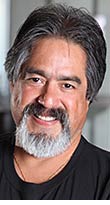Interdisciplinary initiatives earn Regan Prize for Warden, Vanegas

Jorge Vanegas

Robert Warden

J. Thomas Regan
Past Regan Prize recipients:
[Carol Lafayette] (http://one.arch.tamu.edu/news/2010/11/16/lafayette-presented-regan-interdisciplinary-prize-during-deans-advisory-council-gathering/)
[Anat Geva] (http://one.arch.tamu.edu/news/2011/11/22/geva-earns-regan-prize/)
[José Fernández-Solís] (http://one.arch.tamu.edu/news/2013/3/6/solis-reagan-prize/)
[Mark Clayton] (http://one.arch.tamu.edu/news/2014/1/17/professor-earns-regan-prize-interdisciplinary-initiatives/)
For championing interdisciplinary education two Texas A&M College of Architecture professors, Jorge Vanegas, dean of the college, and Robert Warden, director of the [Center for Heritage Conservation] (http://chc.arch.tamu.edu/) , were selected as recipients of the 2014 J. Thomas Regan Interdisciplinary Faculty Prize.
The prize was established by the college’s Dean’s Advisory Council to honor former dean J. Thomas Regan, a champion of interdisciplinary education in the built environment disciplines, who [died] (http://one.arch.tamu.edu/news/2015/3/6/regan/) March 5, 2015 in his Cape Cod, Mass. home.
Jorge Vanegas
“Dean Vanegas has been a highly effective catalyst for interdisciplinary efforts in teaching, research and outreach,” said George J. Mann, holder of the Skaggs Professorship of Health Facilities Design, in a Regan Prize nomination letter.
Vanegas led a college partnership with Mays Business School and Blake Petty, assistant vice president for innovation and business development at Texas A&M, to establish [Startup Aggieland] (http://startupaggieland.com/) , a business incubation center for student entrepreneurs.
The center earned national attention soon after its 2012 founding when then-Texas A&M president J. Bowen Loftin was invited to [present] (http://tamutimes.tamu.edu/2012/09/27/president-loftin-to-discuss-startup-aggieland-business-incubator-at-commerce-dept-forum/#.VJMnPYdseRA) the Startup Aggieland concept at a U.S. Department of Commerce forum in Washington, D.C.
Startup Aggieland was cited as an excellent best practice that helps to spur innovative growth and education in an institution of higher learning by Nish Acharya, director of the department’s Office of Innovation & Entrepreneurship and senior adviser to the Secretary of Commerce.
More national recognition came to Startup Aggieland this year when it was named one of the top three university-based business incubation centers in the United States by the [Collegiate Entrepreneurs Organization] (http://www.c-e-o.org/) at its annual 2014 national conference.
Under Vanegas’ leadership, the college also launched a new course in which its students join engineering and business undergraduates to create an idea for a product or service and develop a business plan to launch it.
“Four of the six teams in Vanegas’ fall 2013 class launched businesses based on their ideas,” said Mann in his nomination letter.
Vanegas is also an instructor in [The Design Process] (http://archcomm.arch.tamu.edu/archive/news/fall2009/stories/Rodney_design.html) , a creativity workshop that attracts majors from throughout campus. In the class, students spark, explore, discover and develop creative, problem-solving abilities and an entrepreneurial spirit in interdisciplinary teams.
The brew of disciplines and ideas in the class regularly result in product concepts that nab top honors in creativity and entrepreneurial contests across the country.
Robert Warden
Robert Warden, professor of architecture and fellow Regan Prize winner has assembled interdisciplinary teams of collaborators to document historic sites around the world, including Europe, Alcatraz Island and a Central American jungle.
“His efforts enable undergraduate and graduate students to work alongside architects, archaeologists and museum conservators,” said Julie Rogers, senior lecturer of architecture and associate CHC director, in a Regan Prize nomination letter.
Warden and an interdisciplinary CHC team’s research findings [helped save] (http://one.arch.tamu.edu/news/2012/3/13/pointe-du-hoc/) an imperiled cliffside monument at Pointe du Hoc, France, that honors the D-Day heroics of U.S. Army Rangers led by future Texas A&M president Earl Rudder.
Civil engineering students on the CHC team concluded that filling caverns underneath the base of the monument with concrete was a crucial step to save it from falling into the sea. A French company performed stabilization work based on the CHC team’s findings.
In another Warden-led project, architecture and civil engineering students from Texas A&M are working with students and faculty from Chico State University’s Concrete Industry Management Program to create 2- and 3-dimensional models of California’s historic [Alcatraz prison] (http://one.arch.tamu.edu/news/2011/6/21/chcscans/) and its support buildings.
“These models and associated research are assisting the National Park Service’s preservation and conservation efforts on Alcatraz Island,” said Rogers.
Warden and students from various disciplines have also been part of a multiyear effort to [create] (http://one.arch.tamu.edu/news/2012/10/25/chc-projects/) models of an ancient Maya site in Belize, where archaeologists have been conducting excavations since 1992.
He also invites a wide variety of speakers to the CHC’s annual historic preservation [symposium] (http://one.arch.tamu.edu/news/2014/2/11/march-chc-symposium-feature/) , said Rogers.
“The symposium is an annual gathering of students, faculty and professionals from a variety of preservation disciplines, including preservation architects, archaeologists, engineers, developers, economists, community leaders and software designers,” she said.
Tags
- architecture
- college culture
- entrepreneurship
- feature
- global college
- heritage conservation
- history
- honors
- interdisciplinary
- outreach
- partnerships
- rss
Related Posts

Arch prof helping restore original hues of Bermuda houses
Aggie-founded arch program flourishing in Bangladesh

Students creating high-density plans for Texas A&M

Students use digital gear in Italy in fall 2016 CHC workshop
Professor Hill earns President's Volunteer Service Award
Follow Us
Facebook Twitter Vimeo Youtube Flickr RSS
Recent Posts

Planning prof heads study of disaster housing aid

A message from the dean

Former student remembered as expert planner

Leading educator named new head of Architecture Dept.






_thumbnail_small.png)
